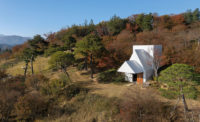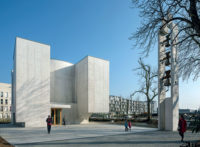Portuguese Chapel by Álvaro Siza
Algarve, Portugal

Photo © João Morgado

Photo © João Morgado

Photo © João Morgado

Photo © João Morgado

Photo © João Morgado

Photo © João Morgado

Photo © João Morgado

Photo © João Morgado

Photo © João Morgado

Photo © João Morgado










“It was like returning to the roots of architecture,” Álvaro Siza says about the experience of creating a small chapel at the top of a hill, on former farmland in Portugal. The first project by the Portuguese Pritzker Prize–winner to be built in the Algarve, the country’s southernmost region, it would also be the first part of a larger spiritual retreat. The pristine sanctuary is pure form—devoid of plumbing, HVAC, and electrical systems.
The plan took shape two years ago, when the clients, a Swiss/American couple who met and married in Portugal in the 1980s, approached the architect. They wanted to develop a self-sustaining project in the region and asked him to design a focal point. “A chapel seemed like a good way to start,” they explained. Overlooking their property, such a building, they felt, would set a positive tone for the land’s future development.
The architect was no less mindful and detailed-oriented in his design, despite its very small scale, than in larger projects, such as the church and community center he recently completed in Rennes, France. “Not to degrade a beautiful landscape” was his biggest challenge. Only 22 feet high, the one-story, 702-square-foot building not only respects but elevates its surroundings, appearing as a spiritual oasis at the end of a footpath, its only means of access. A forecourt extending on the west is roughly the same footprint as the structure and helps integrate the chapel into the sloped terrain by creating the right balance between its vertical and horizontal planes.
A south-facing entry leads to an open passage where three murals, drawn by Siza on Portuguese ceramic tiles, depict the birth, baptism, and death of Jesus Christ. Strategic openings in the roof and walls allow for natural ventilation as well as ample daylight to flood the white, partially tiled interior. The brick structure, coated in plaster, and a green roof insulate the chapel from weather extremes. The architect also designed the furniture inside, and the simple 7½-foot wood cross.
The building’s context, says Siza, informed his selection of materials. “This is but one more building in a farm with other small buildings nearby, close in spirit and in terms of materials.” He chose cream Portuguese limestone to line the courtyard and interior floors, while the plaster on the facade is beige, to blend with the sand-colored soil of the landscape.
Completed and consecrated in March, the humble house of prayer appears at peace with its surroundings. “For a moment,” says Siza, “architecture has been freed from its typical specialties and their regulations.”














